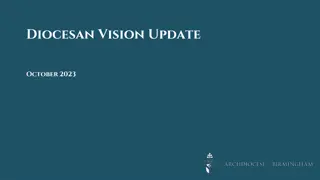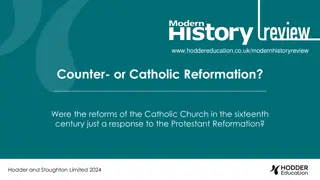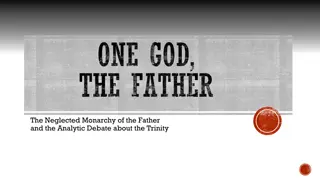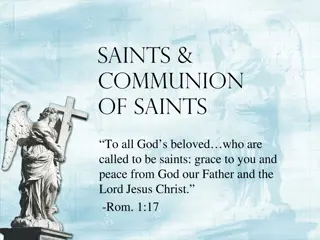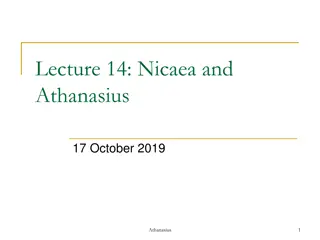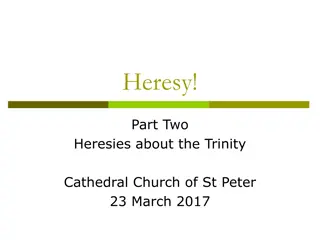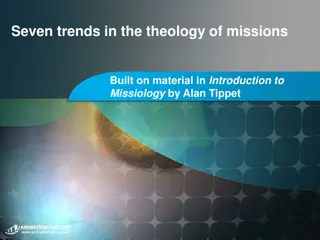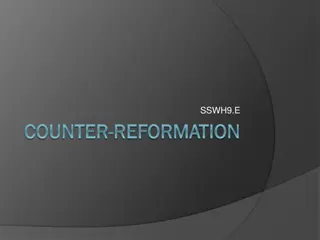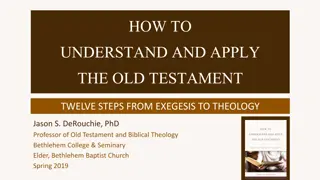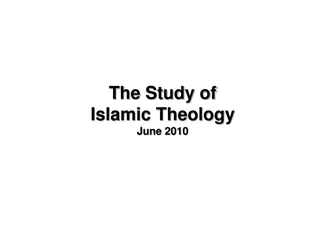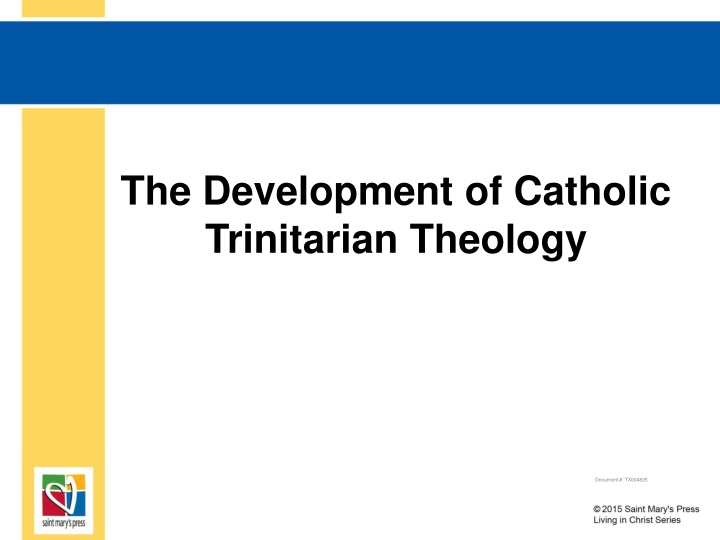
The Development of Trinitarian Theology in Catholic Church History
Explore the evolution of Trinitarian theology in the Catholic Church, from early challenges in understanding Jesus to the resolution of Christological heresies through Ecumenical Councils. Delve into the context of the Early Church and the doctrinal clarifications that shaped Christian beliefs.
Download Presentation

Please find below an Image/Link to download the presentation.
The content on the website is provided AS IS for your information and personal use only. It may not be sold, licensed, or shared on other websites without obtaining consent from the author. If you encounter any issues during the download, it is possible that the publisher has removed the file from their server.
You are allowed to download the files provided on this website for personal or commercial use, subject to the condition that they are used lawfully. All files are the property of their respective owners.
The content on the website is provided AS IS for your information and personal use only. It may not be sold, licensed, or shared on other websites without obtaining consent from the author.
E N D
Presentation Transcript
The Development of Catholic Trinitarian Theology Document #: TX004825
General Overview of Trinitarian Theology Trinitarian theology developed over time through God s Revelation and guidance. The Church clarified the truth of the doctrine through Ecumenical Councils. Ecumenical Councils are gatherings of Church leaders called to resolve pressing issues in the Church. Public domain
Context of the Early Church Early Church communities were widespread around the Roman Empire. Communication between the early Church communities was limited and challenging. Many people had their own theories about who Jesus was and what his time on earth achieved. In some cases, it took years for theological issues to be raised and clarified. Early Ecumenical Councils developed the vocabulary and the process to express the depth, breadth, and meaning of sacred truths.
Christological Heresies During the first several centuries of the Church, some Christological heresies, or incorrect beliefs about Jesus, developed: Docetism Gnosticism Arianism Nestorianism Monophysitism Public domain
Christological Heresies (contd.) Docetism The name comes from Greek dokein, meaning to seem or to appear. This heretical doctrine said Jesus only appeared to have a human body, so his suffering and Death were not real. Docetism said Jesus is God, but only in disguise. Docetism denied the fully human qualities of Jesus.
Christological Heresies (contd.) Gnosticism The name comes from Greek gnosis, meaning knowledge. Gnosticism refers to several religious movements that claimed salvation only comes from secret knowledge from God or from God s agent or elite. Gnosticism first appeared in the second century, but it has continued in various forms to the present day.
Christological Heresies (contd.) Arianism The name comes from the teachings of Arius (AD c. 256 336). This heresy considered Jesus to be a higher creature than humans, but less than God. Arianism denied the eternal existence of the Son of God with God the Father. In other words, it denied Jesus divinity, saying he was human like us and did not exist (had no essence) before he was conceived. Arianism was declared a heresy at the First Council of Nicaea.
Christological Heresies (contd.) Nestorianism The name comes from the teachings of Nestorius (AD 386 451), patriarch of Constantinople. This heresy taught that Jesus has two complete natures and is therefore two persons: one divine and one human. This also meant that Mary was the Mother of Jesus but not the Mother of God. Nestorianism was rejected by the Council of Ephesus in 431. The Council taught that the human and divine natures are united in the one person of Christ.
Christological Heresies (contd.) Monophysitism The name comes from the Greek monastikos, meaning single, and physis,meaning nature. The name refers to the position that Christ has only a single divine nature. This heresy believed that Jesus divinity fully absorbed his humanity, so that in the end he was only divine and not human. Monophysitism was rejected by the Council of Chalcedon in AD 451. The Council taught that Christ has a human and a divine nature.
Overview of Ecumenical Councils Between AD 325 and 787, seven Ecumenical Councils were held to define Christological and Trinitarian doctrines: o First Council of Nicaea (AD 325) o First Council of Constantinople (AD 381) o Council of Ephesus (AD 431) o Council of Chalcedon (AD 451) o Second Council of Constantinople (AD 553) o Third Council of Constantinople (AD 680) o Second Council of Nicaea (AD 787) The two most important, the First Council of Nicaea and Chalcedon, took place in modern-day Turkey.
The First Council of Nicaea, AD 325 This was one of the most significant Councils. It declared that Jesus is truly God. It declared that God the Son is of the same substance as God the Father. It countered Arianism. God from God, Light from Light, true God from true God, begotten, not made, consubstantial with the Father (The Nicene Creed) Public domain
The Council of Chalcedon, AD 451 It focused on God the Son. Attended by 350 bishops. It declared that Jesus has two natures: human and divine, undivided and inseparable. o Jesus is 100 percent human and 100 percent divine. o Jesus is not half human and half divine, nor two persons pushed into one. o Jesus, God the Son, is one Divine Person. Public domain


